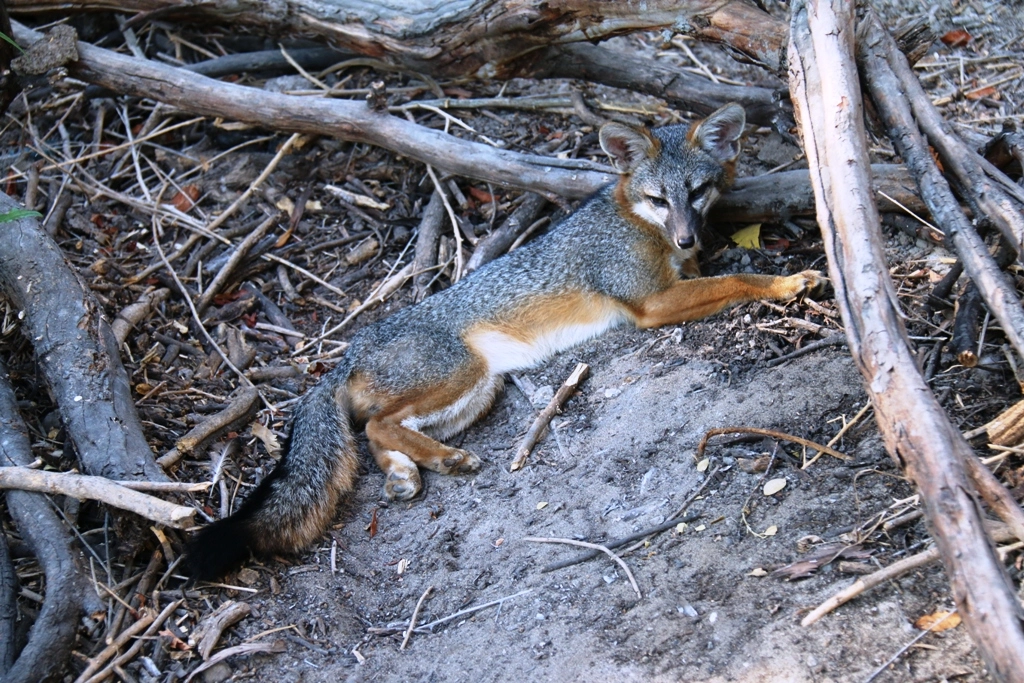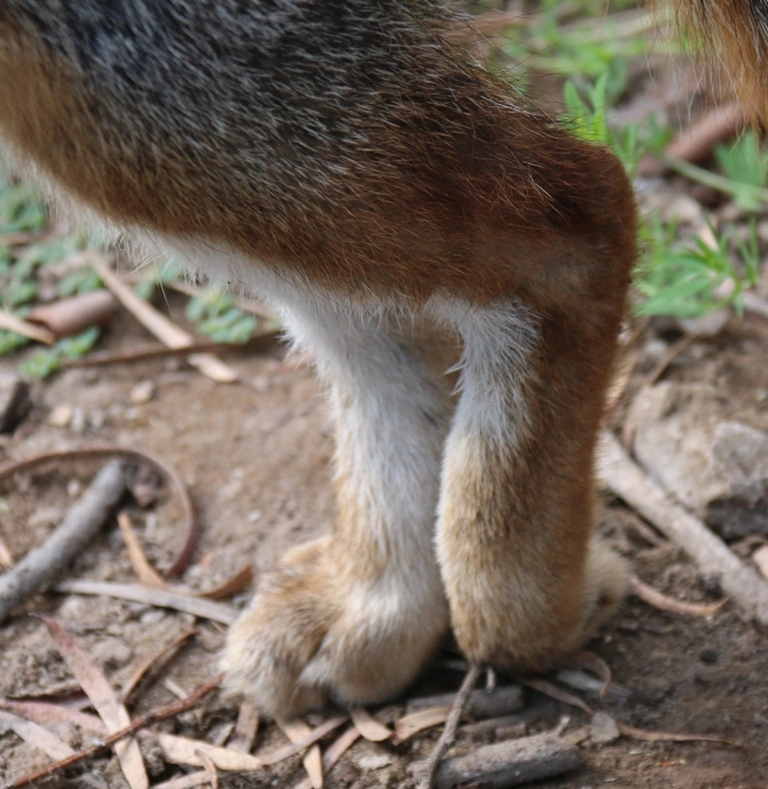Head Shaking & Injuries
by William C. Leikam
President, CEO & Co-founder, Urban Wildlife Research Project
The Environmental Volunteers presents A Year with the Urban Gray Fox by Bill Leikam – the Fox Guy –on Saturday, July 31st 1:30 pm to 2:30 pm – Pre-registration required at https://www.evols.org/blog/event/bill-leikam-urban-gray-fox-talk/
“Join us for this informative and engaging multi-media presentation about the gray fox. Although gray foxes are frequently spotted in the Bay Area, very little is known about them, especially their behavior.”

Skittish Big Eyes
As I’ve noted over the past three months, Big Eyes hyper-skittishness has to be a result of her hormones. If memory serves me, last year when she was skittish, it blew over within a month, month and a half. Not this time. She remains so skittish that I have only seen her several times on our trail cameras and once live over this past month.

Head Shaking Continues
And then there’s her mate Laimos. I am once again seeing that Laimos continues to violently shake his head. Dr. Chad Alves said that there’s probably something stuck in his ear, but I wonder because it seems to be going on for far too long. I say that only because, as I’ve mentioned before, gray fox pairs have an ear cleaning ritual that they perform on one another. For instance, Big Eyes would likely press Laimos head to the side and then she’d lick deep in his ear canal and lap out any of the vermin. I’ve seen this ritual live and with many foxes, but not once have I seen these two perform any ear cleaning on each other but that’s not to say that that they don’t.

Injuries & Healing
Wednesday, June 9, 2021 from my log entry. “Laimos was up on the branch of the huge fallen eucalyptus tree licking his paw. He had injured it and as I watched it became clear that he didn’t put pressure on that leg. He held it off from the branch and he frequently stopped and licked it.” I expected that his injury would be healed within a week and it was.
Over the years I’ve seen many injured gray foxes and invariably, as I’ve said in the past, I am amazed at how quickly they heal. “In a serious gray fox fight, not just a scrap, there is a strong tendency for an attack on the hind quarters and the ears.” In 2014 the alpha female pup of the region Daring, got into a fight that was so serious that she could not climb trees because her hind right leg had been severely slashed. Her ear’s cartilage had been broken and her ear flopped over. Daring limped, she could not bound into the weeds for a rodent. Her hearing had been seriously impaired. Daring was severely handicapped and yet, within a month and a half she no longer limped, her ear had regained much of its cartilage and it almost stood upright.
In such cases we are often, as I was in the beginning of this study, too quick to alert authorities about a wild animal being injured. This often leads to a park ranger setting a live trap, capturing the injured animal, removing it from its home turf, putting it in an animal “hospital” where it will be evaluated as based on a preexisting set of criterions. If the injury is slight such as with Laimos injured paw, the animal will likely be rehabilitated, but, as in Daring’s case recovery may be considered too long, taking up staff time and resources and so in the end, Daring would likely have been euthanized.
Gray Foxes General Health
These two foxes appear to be in good health with the exception of this headshaking.
Total Numbers of Gray Foxes in the Palo Alto Baylands Nature Preserve
As of June, 2021, we have two adult gray foxes living in the Palo Alto Baylands Nature Preserve.
Section II
Update for the Urban Wildlife Research Project
The collaring project needs in excess of $35,000 and here’s the reason why you should consider a donation to UWRP be it $1 or $5,000 or more so that we can begin the collaring project dedicated to making the baylands along the San Francisco Bay a healthy place for wildlife to live. You can donate through PayPal or Give Direct, our preferred portal for giving. On our website (Urban Wildlife Research Project), check out the short video and go to the donate button nearby. Your donation is tax deductible.
Check out our Facebook page.
BE SURE TO check out our YouTube Channel for some incredible wildlife videos at https://www.youtube.com/channel/UC5ujc7p8dU1-O5AbPAWz2_Q
Check out Bill’s interview of January 1, 2021, hosted by the Town of Woodside California for their First Friday event at https://youtu.be/QrZzvmrqKTA
Undoubtedly the best Radio interview – KALW (Local PBS) Audio Recording Interviewed by Sofie Kodner during December 2020 – Broadcast 1/11/2021 5:00 PM on PBS’s program Crosscurrents https://www.kalw.org/post/bay-area-wildlife-habitats-are-disappearing-fox-guy-has-plan
Bill had a conversation with John Muir Laws and Marcia Sivek during a drawing workshop featuring the gray fox with the renowned artist John Muir Laws on January 14, 2021. It aired from noon until 1:30 PM. The Gray Fox: Art and Conservation • John Muir Laws
You can access Bill’s PowerPoint presentation Corridors & Connections: Sustaining the Health of All Wildlife presented during the October 24th P-22 Urban Wildlife Festival here: https://www.youtube.com/watch?v=Dh4MQL1D1Cc
NEW – To find out more about us, search Urban Wildlife Research Project, UWRP, gray foxes, wildlife connection, linkages, corridors and several documentaries including the video clips
If you haven’t had a chance to read some of the articles that have been written about our study of gray fox behavior and our corridor work, click on these links as they will take you to the source: Bill Leikam – The Fox Guy, and Greg Kerekes & URWP
Section III
Gray Fox, Baylands Goals
Within the permit that allows the Urban Wildlife Research Project to conduct its study of the behavior of the gray fox at the Palo Alto Baylands Nature Preserve, the objectives covered area:
- Monitoring of urban gray fox Denning sites in Palo Alto Baylands.
This is being accomplished during the period when the gray foxes use a den site. It is one of the prime locations for gathering most of the behavioral data of the litter and for adults alike.
- Assessment of status and population trends of Baylands urban gray foxes
Since January 2019 a pair of resident gray foxes have claimed territory at the Palo Alto Baylands Nature Preserve.
- Identification of habitat features that promote the presence of urban gray foxes
After considering this and talking with people who know how to restore habitats, we need to assess what kinds of plants, including the Alkaline Salt Bush, would grow best along the edge of the saltwater channel and alongside the marsh. We need to grow a permanent habitat that contains the corridors and plant it as soon as possible. We’ll keep an eye on this as this is a critical link between the southern region of the Baylands and the northern region.
- Assessment of reproductive success and identification of factors that promote successful reproduction
Open up the pinch-point along Matadero Creek by developing thickets that link one area to another, instead of the present “islands”.
- Identification and assessment of possible dispersal travel routes.
Presently there can only be guesses as to dispersal travel routes. We intend to make this important question much more concrete when we attain our collaring/take/capture permit from the Department of Fish & Wildlife.



